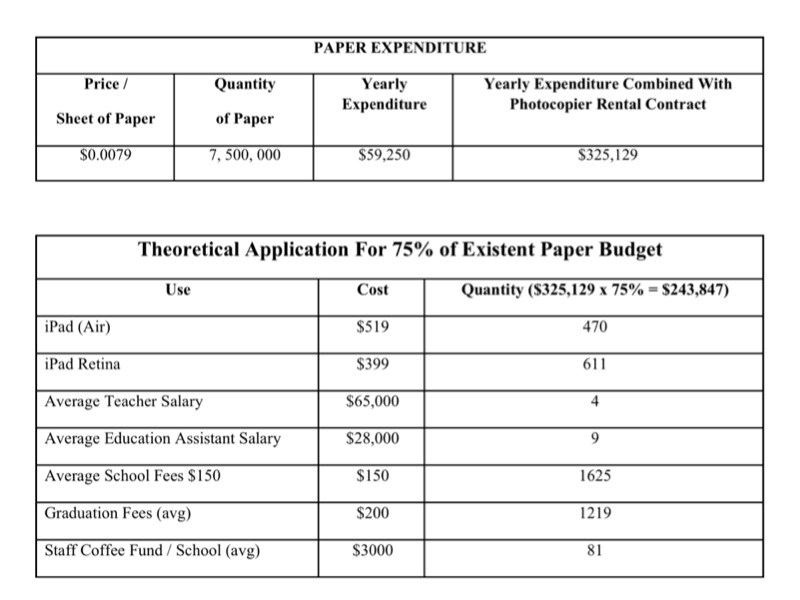Edwin Parr Composite social studies teacher Charles Beamish asks: if the price of gas had not risen in the ‘70s, would we have switched to more compact, fuel-efficient cars?
Likely not, he told the Aspen View Public School board last Thursday in a presentation about switching from a persistent reliance on paper to more digital schoolwork.
The average North American teacher uses 30,000 sheets of paper in a year, he said. In Aspen View, the average is closer to about 40,000, he estimated.
“I know there’s teachers using 150,000 sheets a year,” he added. “It is an insane amount of paper.
The reason division schools still burn through so much paper in a year, posited Beamish, is that paper still comes relatively cheap. He suggested Aspen View wean itself off the majority of its paper use in three steps.
First, he said, give all staff a unique printer code and monitor photocopy use for a year. Next, locate “curriculum leaders”: teachers in different subject areas who have already made strides in switching to digital assignments and who are willing to help other teachers learn. Third, after studying the results of the paper usage monitoring, administration can allocate a reduced amount of paper across the division.
Beamish also suggested a fourth step: make the new secondary school a BYOD, or “bring your own device,” school.
Beamish acknowledged such a move will likely meet with some concerns, chief among them the worry that not all families can afford a tablet or comparable device.
But Beamish pointed out that Aspen View has roughly one computer per two students, so computers or the division’s own devices could be used where needed.
Trustees acknowledged that students are already required to buy a graphing calculator, which can cost $100–$150. Tablets start at under $150, and a graphing calculator app can be downloaded onto them.
The paper issue is not purely environmental, said Beamish.
“I think a lot of our other digital initiatives are being stalled by our access to paper,” he said.
He added that fighting with photocopiers and printing reams of assignments also eats up teachers’ time. When he started making assignments and copies of old exams into .pdfs (a type of computer file that allows you to control who can open it and who can print it, among other features), he found he could post class materials to a website called Weebly. Students and parents can access the site by password from anywhere.
Students also submit their essays to him by email, and he tracks his changes and comments in a computer document to email back to them. When parent-teacher interviews roll around, he can instantly pull up a student’s assignments to show parents specifically what sort of feedback he’s been giving them.
Beamish has also used Facebook by creating a closed group for his class (he can’t see students’ personal information, nor can they see his). He said while we’ve traditionally thought of essay-writing as solo work, collaborative endeavours like Wikipedia (where anyone can edit and add to an encyclopedia entry) have shown free sharing of ideas is the way forward. He encourages students to share the examples they’re planning to use in upcoming essays. The result? Better essay quality overall, he said.
The trustees applauded Beamish’s vision.
“I can see some of this fitting into the next three-year priority list,” said chair Paul Ponich.
Trustee Trevor Yeaman questioned if digital reform would be stressful for less computer-savvy teachers.
Beamish said the changes he envisioned would not be that difficult.
“Instead of hitting print, you go to the left and hit .pdf,” he said.
Aspen View only spends $60,000 a year on paper, Beamish pointed out — not a big chunk of its budget. However, rental and maintenance costs for equipment like photocopiers are over the quarter-million mark.
Trustee Dennis MacNeil said just by reducing paper use, the money could be put back into purchasing devices to supplement the “BYOD” idea, while Pat Pedersen pointed out that $60,000 is still someone’s wage.


